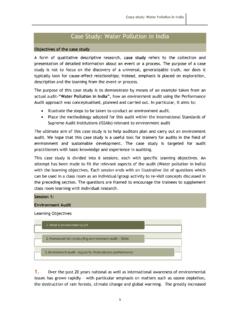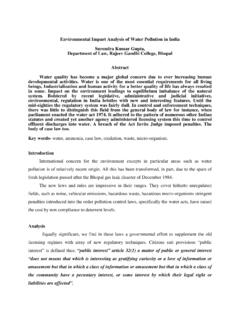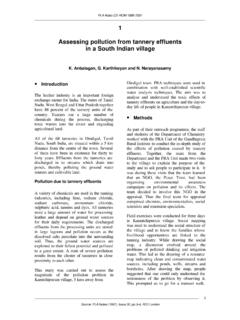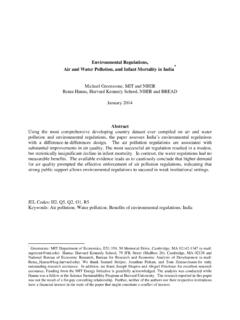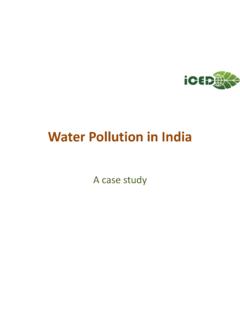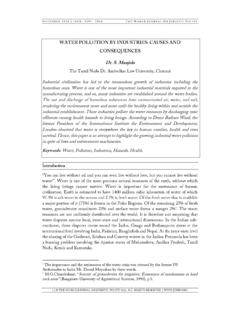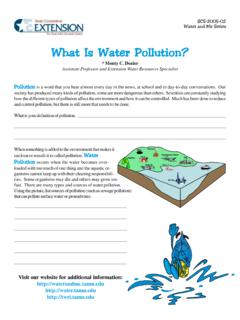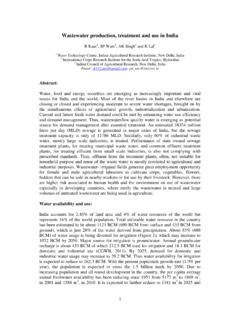Transcription of WATER POLLUTION: CAUSES, EFFECTS AND REMEDIES
1 International Journal of Advanced Technology in Engineering and Science Volume , Issue No. 08, August 2014 ISSN (online): 2348 7550 70 | P a g e WATER pollution : causes , EFFECTS AND REMEDIES Udaybir Singh Mann1, Arvind Dhingra2, Jaswinder Singh3 (Biological sciences & chemistry), University of Alberta, Edmonton, CANADA 2 Assistant Professor, Department of EE, GNDEC, Ludhiana,(India) 3 Associate Professor & HOD, Department of EED, GNDEC, Ludhiana,(India) ABSTRACT WATER is one of the necessities for existence of mankind. It is also one of the most abundantly available resources. But indifference of mankind and its abuse of the plentiful resource made WATER scarcity a problem for many nations around the globe.
2 WATER pollution is one major problem that demands utmost attention to deal with emerging WATER crisis. This paper is an attempt to describe various causes and REMEDIES for WATER pollution . Keywords -- WATER pollution , Plentiful Resource, REMEDIES For WATER pollution I. INTRODUCTION As stated by Wikipedia, WATER pollution is the contamination of WATER bodies ( lakes, rivers, oceans, aquifers and groundwater). WATER pollution occurs when pollutants are directly or indirectly discharged into WATER bodies without adequate treatment to remove harmful compounds. WATER pollution affects plants and organisms living in these bodies of WATER . In almost all cases the effect is damaging not only to individual species and populations, but also to the natural biological communities.
3 As we see around the earth, there is plenty of WATER . Infact 70% of earth is covered with WATER . But hardly 2% of it is drinkable. We all know that WATER is very essential for existence of human beings. With the growing population and mismanagement of WATER resources, scarcity of WATER has become a bane in India and the rest of the world. The WATER is available to us from various resources. But unmindful use of these resources has led to a WATER crisis. Also with the growing industrialization and urbanization, pollution of WATER has become a major problem that needs to be tackled. II. WATER pollution The various sources of WATER include; groundwater, surface WATER . Both these resources are in danger due to overuse and misuse.
4 The following figure shows the major contributors to WATER pollution . Figure : 01 International Journal of Advanced Technology in Engineering and Science Volume , Issue No. 08, August 2014 ISSN (online): 2348 7550 71 | P a g e The ground WATER is susceptible to contamination from sources that may not directly affect surface WATER bodies, and the distinction of point vs. non-point source may be irrelevant. A spill or ongoing releases of chemical or radionuclide contaminants into soil (located away from a surface WATER body) may not create point source or non-point source pollution , but can contaminate the aquifer below, defined as a toxin plume.
5 The movement of the plume, called a plume front, may be analyzed through a hydrological transport model or groundwater model. Analysis of groundwater contamination may focus on the soil characteristics and site geology, hydrogeology, hydrology, and the nature of the contaminants. A number of contaminants are responsible for ground WATER contamination including a wide variety of chemicals and pathogens. Most these lead to reduction in normal oxygen content in WATER and hence make it unfit for consumption. Many areas of groundwater and surface WATER are now contaminated with heavy metals, POPs (persistent organic pollutants), and nutrients that have an adverse affect on health.
6 WATER -borne diseases and WATER -caused health problems are mostly due to inadequate and incompetent management of WATER resources. Safe WATER for all can only be assured when access, sustainability, and equity can be guaranteed. Access can be defined as the number of people who are guaranteed safe drinking WATER and sufficient quantities of it. There has to be an effort to sustain it, and there has to be a fair and equal distribution of WATER to all segments of the society. Urban areas generally have a higher coverage of safe WATER than the rural areas. Even within an area there is variation: areas that can pay for the services have access to safe WATER whereas areas that cannot pay for the services have to make do with WATER from hand pumps and other sources.
7 In the urban areas WATER gets contaminated in many different ways, some of the most common reasons being leaky WATER pipe joints in areas where the WATER pipe and sewage line pass close together. Sometimes the WATER gets polluted at source due to various reasons and mainly due to inflow of sewage into the source. Ground WATER can be contaminated through various sources and some of these are mentioned below. Pesticides. Run-off from farms, backyards, and golf courses contain pesticides such as DDT that in turn contaminate the WATER . Leechate from landfill sites is another major contaminating source. Its EFFECTS on the ecosystems and health are endocrine and reproductive damage in wildlife.
8 Groundwater is susceptible to contamination, as pesticides are mobile in the soil. It is a matter of concern as these chemicals are persistent in the soil and WATER . Sewage. Untreated or inadequately treated municipal sewage is a major source of groundwater and surface WATER pollution in the developing countries. The organic material that is discharged with municipal waste into the watercourses uses substantial oxygen for biological degradation thereby upsetting the ecological balance of rivers and lakes. Sewage also carries microbial pathogens that are the cause of the spread of disease. Nutrients. Domestic waste WATER , agricultural run-off, and industrial effluents contain phosphorus and nitrogen, fertilizer run-off, manure from livestock operations, which increase the level of nutrients in WATER bodies and can cause eutrophication in the lakes and rivers and continue on to the coastal areas.
9 The nitrates come mainly from the fertilizer that is added to the fields. Excessive use of fertilizers cause nitrate contamination of groundwater, with the result that nitrate levels in drinking WATER is far above the safety levels recommended. International Journal of Advanced Technology in Engineering and Science Volume , Issue No. 08, August 2014 ISSN (online): 2348 7550 72 | P a g e Good agricultural practices can help in reducing the amount of nitrates in the soil and thereby lower its content in the WATER . Synthetic organics Many of the 100 000 synthetic compounds in use today are found in the aquatic environment and accumulate in the food chain.
10 POPs or Persistent organic pollutants, represent the most harmful element for the ecosystem and for human health, for example, industrial chemicals and agricultural pesticides. These chemicals can accumulate in fish and cause serious damage to human health. Where pesticides are used on a large-scale, groundwater gets contaminated and this leads to the chemical contamination of drinking WATER . Acidification. Acidification of surface WATER , mainly lakes and reservoirs, is one of the major environmental impacts of transport over long distance of air pollutants such as sulphur dioxide from power plants, other heavy industry such as steel plants, and motor vehicles. This problem is more severe in the US and in parts of Europe.
